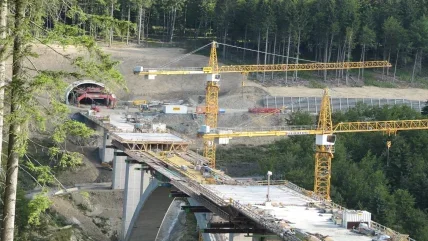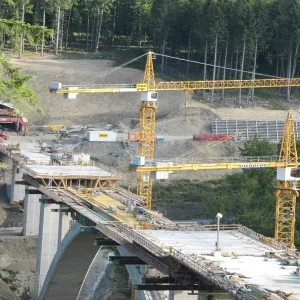
The tunnelling industry is susceptible to economic downturns, which can result in reduced infrastructure spending, project cancellations, and decreased demand for tunnel construction services. Economic downturns, such as recessions or financial crises, pose significant challenges to tunnelling projects, impacting project viability, financing options, and workforce stability. To navigate these challenges successfully, stakeholders in the tunnelling industry must adopt proactive strategies to mitigate the risks associated with economic downturns. This article explores various strategies and best practices to combat the risk of economic downturns in the tunnelling industry.
Understanding the Risks: Before delving into mitigation strategies, it’s essential to understand the specific risks that economic downturns pose to the tunnelling industry:
- Reduced Infrastructure Spending: During economic downturns, governments and private investors may reduce infrastructure spending to prioritise other areas of the budget, leading to delays or cancellations of tunnelling projects.
- Financing Constraints: Economic downturns can restrict access to financing options for tunnelling projects, making it challenging to secure funding for project development, construction, and operations.
- Project Cancellations: Uncertainty about future economic conditions may prompt project owners to cancel or postpone planned tunnelling projects, resulting in lost opportunities and decreased revenue for tunnelling contractors and suppliers.
- Decline in Demand: Economic downturns can lead to a decline in demand for tunnel construction services, as clients delay or scale back infrastructure investments, impacting the workload and profitability of tunnelling companies.
Mitigation Strategies:
To mitigate the risks associated with economic downturns in the tunnelling industry, stakeholders can implement various strategies and measures:
- Diversification of Market Segments: Diversify the portfolio of tunnelling projects across different market segments, such as transportation, water infrastructure, energy, and mining. This helps mitigate the impact of economic downturns by reducing dependence on any single sector or client.
- Geographic Diversification: Expand operations into new geographic markets with stable economic conditions and strong demand for infrastructure projects. Diversifying the geographic footprint can help offset the effects of economic downturns in specific regions or countries.
- Long-Term Contracts and Partnerships: Secure long-term contracts and partnerships with government agencies, utilities, and private sector clients to provide stability and predictability to tunnelling projects. Long-term agreements ensure a steady stream of revenue and minimise the impact of short-term economic fluctuations.
- Focus on Maintenance and Rehabilitation: During economic downturns, prioritise maintenance, repair, and rehabilitation projects for existing tunnel infrastructure. These projects are less susceptible to budget cuts and provide a reliable source of revenue for tunnelling contractors and engineering firms.
- Cost Reduction and Efficiency Measures: Implement cost reduction and efficiency measures to streamline operations, optimise resource allocation, and reduce overhead costs. Embrace lean construction practices, digital technologies, and automation to improve productivity and competitiveness in a challenging economic environment.
- Strategic Investments in Innovation: Invest in research and development initiatives to innovate new tunnelling technologies, construction methods, and materials that offer cost savings, efficiency improvements, and environmental sustainability. Strategic investments in innovation can enhance competitiveness and differentiate tunnelling companies in the marketplace.
- Flexible Contracting Models: Adopt flexible contracting models, such as design-build, public-private partnerships (PPP), and performance-based contracts, that align project incentives, share risks, and provide financial stability for all parties involved. Flexible contracting models can help mitigate the impact of economic downturns on project delivery and financing.
- Risk Management and Contingency Planning: Develop robust risk management strategies and contingency plans to identify, assess, and mitigate potential risks associated with economic downturns. Conduct scenario analysis, stress testing, and sensitivity analysis to evaluate the financial impact of different economic scenarios on tunnelling projects.
Case Studies and Best Practices:
To illustrate the effectiveness of these mitigation strategies, consider the following case studies and best practices from the tunnelling industry:
- Crossrail Project, London, UK: The Crossrail project implemented a diversified funding model, combining government funding, private investment, and bond issuances to finance the construction of a new underground railway line across London. The project’s geographic diversification and long-term contracts with government agencies provided stability and resilience against economic downturns.
- Gotthard Base Tunnel, Switzerland: The Gotthard Base Tunnel, one of the world’s largest and most complex tunnelling projects, utilised innovative design-build contracts and risk-sharing agreements to manage the financial risks associated with construction delays and cost overruns. The project’s focus on efficiency, collaboration, and stakeholder engagement helped mitigate the impact of economic downturns on project delivery and financing.
- East Side Access Project, New York City, USA: The East Side Access project leveraged public-private partnerships (PPP) and performance-based contracts to finance the construction of new underground rail tunnels beneath Manhattan. The project’s flexible contracting model and strategic investments in innovation enabled cost savings, efficiency improvements, and resilience against economic downturns.
Conclusion:
Combatting the risk of economic downturns in the tunnelling industry requires a proactive and multifaceted approach that incorporates diversification, innovation, efficiency, and risk management strategies. By implementing these strategies and adopting best practices, stakeholders can mitigate the impact of economic fluctuations, maintain financial stability, and sustain long-term growth and resilience in the face of economic uncertainty.







